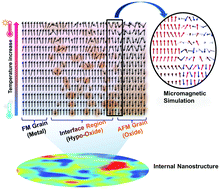Magnetism of the hypo-oxide state at the diffuse interface between the ferromagnet and antiferromagnet phases†
Abstract
At the interface between ferromagnetic and antiferromagnetic phases, various spin configurations with a higher degrees of complexity than in the bulk states can be derived due to the diverse possible interface atomic structures, where coupling interactions among the constituting atoms can form in consistence with altered atomic configurations. The interface magnetic properties then depend on the collective behavior of such spin structures. In the present work, an extended interfacial configuration of a hypo-oxide state was prepared by establishing the gradient of oxygen concentration across the spatially diffuse interface region between ferromagnetic metallic and antiferromagnetic oxide phases at the nanometer scale. With these mixed ferromagnetic and antiferromagnetic couplings among the atoms in the interfacial hypo- or sub-oxide state, novel magnetic behavior can be induced. We report here, for the first time, a significant increase of saturation magnetization with temperature over a broad temperature range, which is against the conventional expectation for any generally known magnetic materials. And the unusual temperature dependent behavior can be understood as the combined effects of competing ferromagnetic and antiferromagnetic couplings acting on atoms in and near the interface region.



 Please wait while we load your content...
Please wait while we load your content...